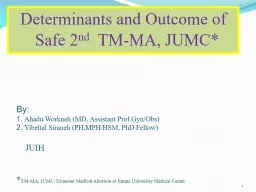PPT-By: 1. Ahadu Workneh
Author : davies | Published Date : 2022-06-18
MD Assistant P rofGyn Obs 2 Yibeltal Siraneh PHMPHHSM PhD Fellow JU IH TMMA JUMCTrimester Medical Abortion at Jimma Univeristy Medical Center
Presentation Embed Code
Download Presentation
Download Presentation The PPT/PDF document "By: 1. Ahadu Workneh" is the property of its rightful owner. Permission is granted to download and print the materials on this website for personal, non-commercial use only, and to display it on your personal computer provided you do not modify the materials and that you retain all copyright notices contained in the materials. By downloading content from our website, you accept the terms of this agreement.
By: 1. Ahadu Workneh: Transcript
Download Rules Of Document
"By: 1. Ahadu Workneh"The content belongs to its owner. You may download and print it for personal use, without modification, and keep all copyright notices. By downloading, you agree to these terms.
Related Documents

